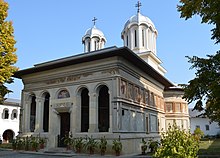Căldărușani Monastery
The Căldărușani Monastery ( Romanian Mănăstirea Căldărușani ) is a Romanian Orthodox monastery in the municipality of Gruiu , in the Ilfov district , in Romania , on the lake of the same name. It was built in 1637 by the Prince of Wallachia, Matei Basarab .
history
The monastery Căldăruşani was built by Prince Matei Basarab on a peninsula on the Căldăruşani Lake , in the Vlăsiei forests , between the years 1637–1638 on the ruins of an old monastery. The prince had a fortress-like structure built, which corresponded to his plans to strategically strengthen Wallachia. This happened at a time when the Turks, as the ruling power in the Romanian countries, had prohibited the construction of defensive fortresses. The monastery is surrounded by walls 6–7 meters high. In times of war, the monastery was also a place of refuge for the residents of the area. Prince Matei Basarab initiated the preparations for the foundation of the monastery a year before construction began by acquiring numerous pieces of land.
description
The church, dedicated to the Holy Martyr Dimitrie , has the shape of a clover leaf, with side wings and is equipped with one large and two small bell towers. The Căldărușani monastery is one of the largest in the country. In the course of history, special figures of the Romanian Orthodox Church have taken the bishop's seat. To mention Filaret , who later became Metropolitan of the country. He had the monastery renovated and the upper floor built. This made him the second founder of the Căldărușani monastery. At the end of the 18th and beginning of the 19th century, the abbot of the Căldărușani Monastery was Gheorghe Cernicanul , an important representative of the Romanian national movement .
Cultural site
The monks of the monastery dedicated themselves to the copying of manuscripts . The painting school of Ivan Rusu was also active after 1802 under the direction of Matei Polcovnicul . Among the particularly valuable museum pieces were seven icons by Nicolae Grigorescu, along with other masterpieces, which can be admired in the monastery museum . Around 1820 the monastery library had 1830 books, 921 of which were Romanian , the rest Greek , Latin , Italian , French and German .
Economic factor
In the course of the 19th century the monastery gained more and more economic power, so that in 1821 new buildings were erected, monastic properties and the houses outside the fortress. The princely monastery had many plots, one hundred estates in seven parts of the country, villages, wine-growing areas , mills , orchards , houses, shops , lakes , salt mountains , spas , oil exploitations , rose wine and other taxes .
Forced residence
In 1948 the Romanian Greek Catholic Church became an underground church after the communist regime banned it and gave its property to the Romanian Orthodox Church. The clergy and lay people who did not bow to these measures were imprisoned by the Romanian state. On May 24, 1950, seven bishops and 21 priests of the Romanian Greek Catholic Church, who had been arrested since 1948, were housed in the Căldărușani monastery for forced residency ( Romanian domiciliu obligatoriu ). From here six of them were transferred to Sighet Prison, where three died ( Ioan Suciu , Valeriu Traian Frențiu and Titu Liviu Chinezu ). The future Cardinal Iuliu Hossu survived the arrest in Sighet and was transferred back to Căldărușani in 1956.
Web links
- manastirea-caldarusani.go.ro , website of the monastery
- ilfov.djc.ro , Mănăstirea Căldărușani
- crestinortodox.ro , Mănăstirea Căldărușani
- ortodox.ro , Mănăstirea Căldărușani
Individual evidence
- ↑ a b c d manastirea-caldarusani.go.ro ( Memento of the original from October 10, 2012 in the Internet Archive ) Info: The archive link was inserted automatically and has not yet been checked. Please check the original and archive link according to the instructions and then remove this notice. , Website of the monastery
- ↑ memorialsighet.ro , Repressions against the Church.
Coordinates: 44 ° 40 ′ 32.3 " N , 26 ° 16 ′ 1.7" E

